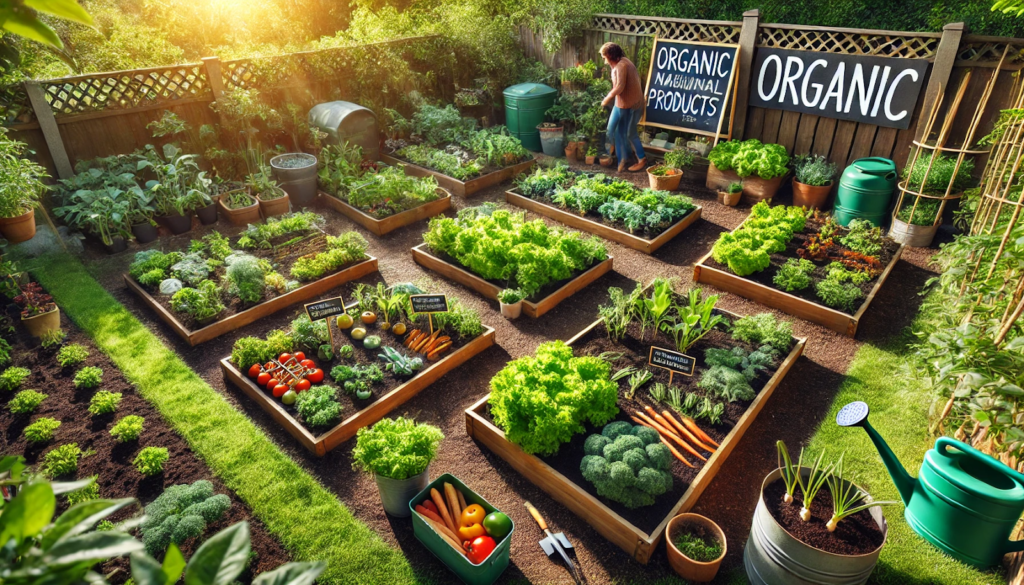Growing your own organic vegetables at home is a powerful way to take control of your food, reduce exposure to harmful chemicals, and support a more sustainable lifestyle. Organic gardening isn’t just about skipping synthetic pesticides—it’s about working with nature to create a healthy, balanced environment where your plants can thrive naturally.
This guide will show you exactly how to grow your vegetables 100% organically, from soil prep to natural pest control and everything in between.
What Does “Organic” Really Mean?
Organic gardening means growing food:
- Without synthetic pesticides or fertilizers
- Without genetically modified organisms (GMOs)
- Using only natural methods to enhance soil and plant health
- With a focus on biodiversity and sustainability
Organic gardening works with nature rather than against it.
Step 1: Start with Healthy, Organic Soil
Soil is the foundation of organic gardening. Healthy soil grows strong plants that naturally resist pests and diseases.
How to Build Organic Soil:
- Add Compost: Improves fertility, texture, and microbial activity.
- Use Aged Manure: Excellent natural source of nitrogen and phosphorus.
- Apply Mulch: Retains moisture, suppresses weeds, and improves soil as it breaks down.
- Avoid Synthetic Additives: No chemical fertilizers or soil conditioners.
Tip:
- Use a simple soil test kit to check pH and nutrient levels before planting.
Step 2: Choose Organic Seeds and Seedlings
Not all seeds are created equal. Look for those specifically labeled as organic or heirloom.
Why It Matters:
- Organic seeds are harvested from plants grown without synthetic chemicals.
- Heirloom varieties often have better flavor and resilience.
Where to Find Them:
- Organic seed companies
- Farmers’ markets
- Certified garden centers
Step 3: Plan Your Garden for Biodiversity
Diversity builds natural resistance and resilience.
Use These Techniques:
- Crop Rotation: Prevents soil nutrient depletion and reduces disease buildup.
- Companion Planting: Pair plants that benefit each other (e.g., basil and tomatoes, carrots and onions).
- Succession Planting: Staggered planting for continual harvest and less pest pressure.
Step 4: Feed Plants Naturally
Avoid synthetic fertilizers by using natural, slow-release nutrients.
Organic Fertilizer Options:
- Compost tea
- Worm castings
- Fish emulsion
- Bone meal
- Seaweed extract
Apply regularly based on your plant’s growth cycle. Most organic fertilizers can be worked into the soil or diluted with water.
Step 5: Water the Right Way
Watering plays a big role in preventing disease and promoting healthy growth.
Best Practices:
- Water at the base of the plant, not the leaves
- Water early in the morning
- Use drip irrigation or soaker hoses to conserve water
- Mulch to reduce evaporation
Tip: Avoid watering in the evening, which encourages fungal growth.
Step 6: Control Pests Naturally
Synthetic pesticides are banned in organic gardens—but that doesn’t mean you have to lose crops to bugs.
Natural Pest Control Methods:
- Neem oil spray: Effective against aphids, spider mites, and more.
- Insecticidal soap: Safe and biodegradable.
- Diatomaceous earth: Deters crawling insects like slugs and beetles.
- Row covers: Protect delicate crops without chemicals.
- Hand-picking pests: Very effective for small infestations.
Beneficial Insects:
- Attract ladybugs, lacewings, and praying mantises by planting nectar-rich flowers nearby.
Step 7: Prevent Disease Organically
Prevention is your best defense in an organic garden.
Strategies:
- Space plants properly for good air circulation
- Rotate crops yearly to reduce soilborne pathogens
- Clean tools regularly to prevent contamination
- Prune infected leaves immediately
Use natural remedies like baking soda and diluted hydrogen peroxide sprays if necessary.
Step 8: Keep Weeds Under Control—Without Chemicals
Weeds compete with your vegetables for nutrients and water.
Organic Weed Control:
- Mulch: Blocks sunlight and prevents weed germination.
- Hand Weeding: Most effective for small areas.
- Boiling Water or Vinegar: Use cautiously around vegetables.
Avoid landscape fabric if you’re rotating crops or digging frequently.
Step 9: Support Soil Life
A healthy organic garden is alive beneath the surface.
How to Nurture Soil Microbes:
- Avoid tilling too often
- Add compost and organic matter regularly
- Water deeply but infrequently
- Leave roots in place after harvest when possible
Healthy soil grows strong plants, and strong plants resist pests and diseases naturally.
Step 10: Harvest and Enjoy Safely
With no synthetic chemicals used, you can confidently enjoy your harvest straight from the garden.
Tips:
- Wash vegetables with water to remove soil or bugs.
- Store fresh produce in cool, dry areas or refrigerate.
- Preserve excess through freezing, drying, or pickling.
Embrace the Organic Gardening Lifestyle
Growing organic vegetables is more than a trend—it’s a commitment to healthier food, cleaner ecosystems, and a deeper connection to your garden. By focusing on natural methods and working in harmony with the environment, you’ll produce vibrant, flavorful vegetables that are as good for the planet as they are for your plate.






